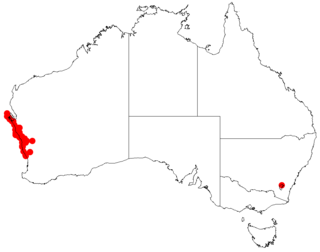
Acacia caesaneura, commonly known as western blue mulga, is a shrub or tree belonging to the genus Acacia and the subgenus Juliflorae that is endemic to western Australia.

Acacia humifusa is a shrub belonging to the genus Acacia and the subgenus Juliflorae that is endemic to northern parts of Australia.

Acacia phacelia, also known as the Kimberley cluster wattle, is a shrub belonging to the genus Acacia and the subgenus Juliflorae that is endemic to a small area in north western Australia.
Acacia claviseta, also known as the club-tipped whorled wattle, is a shrub belonging to the genus Acacia and the subgenus Lycopodiifoliae that is endemic to north western Australia.

Acacia hippuroides is a shrub belonging to the genus Acacia and the subgenus Lycopodiifoliae that is endemic to north western Australia

Acacia idiomorpha is a shrub belonging to the genus Acacia and the subgenus Phyllodineae that is endemic to a small area of western Australia.

Acacia lachnophylla is a shrub belonging to the genus Acacia and the subgenus Phyllodineae that is endemic to south western Australia.

Acacia sabulosa is a shrub of the genus Acacia and the subgenus Phyllodineae that is endemic to north western Australia.

Acacia scalena is a shrub of the genus Acacia and the subgenus Phyllodineae that is endemic to a small area in western Australia.

Acacia cassicula is a shrub of the genus Acacia and the subgenus Plurinerves that is endemic to an area of south western Australia.

Acacia consobrina is a shrub of the genus Acacia and the subgenus Plurinerves that is endemic to south western Australia.

Acacia galeata is a shrub or tree of the genus Acacia and the subgenus Plurinerves that is endemic to an area of western Australia.

Acacia nivea is a shrub of the genus Acacia and the subgenus Plurinerves that is endemic to south western Australia.

Acacia octonervia is a shrub of the genus Acacia and the subgenus Plurinerves that is endemic to a small area along the south western coast of Australia.

Acacia phlebocarpa, also known as tabletop wattle, is a shrub of the genus Acacia and the subgenus Plurinerves and is native to northern Australia.

Acacia setulifera is a shrub of the genus Acacia and the subgenus Plurinerves that is endemic to an area of northern Australia.

Acacia subflexuosa is a shrub of the genus Acacia and the subgenus Plurinerves that is endemic to an area of south western Australia.

Acacia sulcata is a shrub of the genus Acacia and the subgenus Plurinerves that is endemic to an area of south western Australia.

Acacia handonis, commonly known as Hando's wattle or Percy Grant wattle, is a shrub belonging to the genus Acacia and the subgenus Phyllodineae that is native to parts of north eastern Australia. In 2008 it was listed as vulnerable according to the Environment Protection and Biodiversity Conservation Act 1999.

Acacia armitii is a shrub belonging to the genus Acacia and the subgenus Juliflorae that is native to north eastern Australia. It is considered as near threatened in Queensland.



















